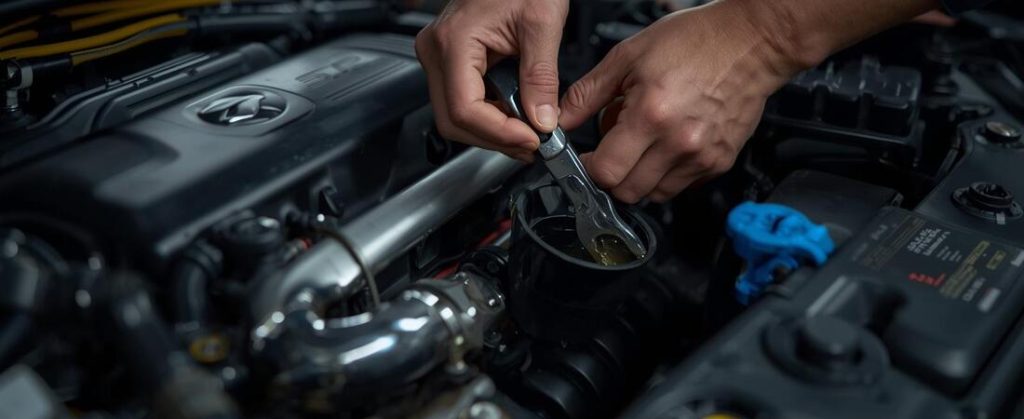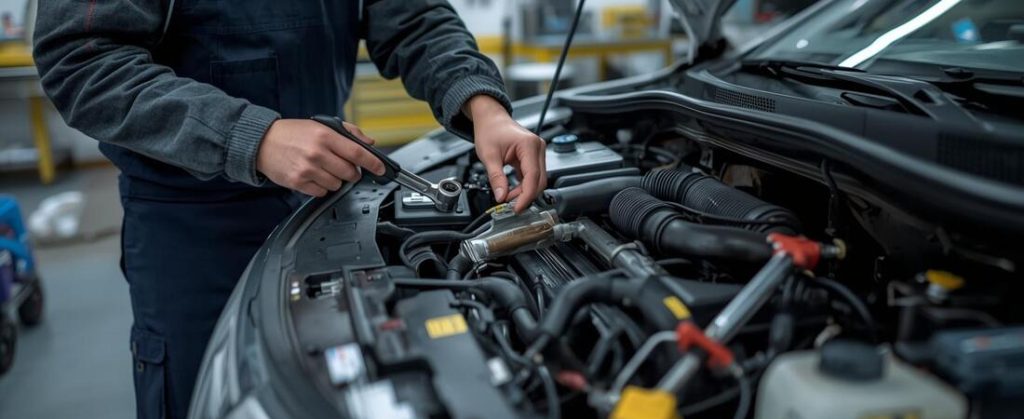This article was updated in November 7, 2025 with new products and information by Mark S. Taylor
Fixing an oil leak in your car can cost between $100 and $2,000. The price depends on the leak’s location and severity.
Oil leaks are common issues that many car owners face. They can lead to bigger problems if not addressed. Understanding the cost to fix an oil leak helps you prepare financially. It also helps you make informed decisions about your car’s maintenance.
This blog post will explain the factors that affect the cost of fixing an oil leak. From the type of car you drive to the complexity of the repair, we’ll cover it all. Stay with us to learn more about what to expect when dealing with an oil leak in your car.

Contents
Common Causes
Fixing an oil leak in your car can be costly. The price depends on the cause. Understanding the common causes can help you plan better. Let’s look at a few key reasons why oil leaks happen.
Worn Out Gaskets
Gaskets seal the engine parts. Over time, they wear out. This can cause oil to leak. Replacing gaskets can fix the issue. It’s a common problem in older cars.
Damaged Oil Pan
The oil pan holds the engine oil. Road debris can damage it. A cracked oil pan leads to leaks. Repairing or replacing the oil pan can solve this problem.
Faulty Oil Filter
The oil filter cleans the engine oil. If it’s faulty, oil can leak. Changing the oil filter regularly can prevent this. A simple fix that saves money in the long run.
Signs Of An Oil Leak
Oil leaks in your car can be tricky to detect. Identifying them early can save you from costly repairs. Here are some signs of an oil leak that you should never ignore.
Oil Spots Under Car
One of the most obvious signs is oil spots under your car. These spots usually appear on the ground where you park. They can be brown or black. Check the ground regularly. If you see these spots, you might have an oil leak.
Burning Oil Smell
A burning oil smell is another common sign of an oil leak. If you notice this odor, it means oil is dripping onto hot engine parts. This can be very dangerous. It can cause engine fires or severe damage. Always take this sign seriously.
Low Oil Levels
If you find your oil levels are consistently low, it could indicate a leak. Regularly check the oil dipstick. If the oil level drops quickly, you might have a leak. Keeping an eye on your oil levels can prevent major issues.

Initial Diagnosis
Identifying the source of an oil leak in your car is crucial. The process involves several steps. Each step helps pinpoint the exact location and severity of the leak. This ensures you only spend what is necessary for repairs. Let’s explore the initial diagnosis.
Visual Inspection
Start with a visual inspection. Park your car on a level surface. Check the area under the engine. Look for any oil spots or stains. Inspect the engine bay and undercarriage. Use a flashlight for better visibility. Common areas to check include:
- Oil filter
- Oil pan
- Valve cover gasket
- Oil drain plug
If you find any wet or oily spots, note their location. This information will be useful for the next steps.
Using A Uv Dye
If the visual inspection is inconclusive, use a UV dye. This method is more precise. Here’s how it works:
- Add UV dye to the engine oil.
- Run the engine for a few minutes.
- Turn off the engine and use a UV light.
- Inspect for glowing areas. These indicate oil leaks.
This method highlights even the smallest leaks. It is a reliable step in the diagnosis process.
Professional Assessment
If you are unsure, seek a professional assessment. Mechanics have the tools and experience to diagnose leaks accurately. They may use advanced equipment like smoke machines. A professional assessment typically involves:
| Inspection Type | Estimated Cost |
|---|---|
| Basic Inspection | $50 – $100 |
| Comprehensive Inspection | $100 – $200 |
Investing in a professional diagnosis can save money in the long run. It ensures the leak is fixed correctly the first time.
Cost Factors
Fixing an oil leak in your car can be expensive. The cost depends on various factors. Understanding these factors helps you budget better. Here are the main cost factors:
Parts Replacement
Parts play a big role in the cost of fixing an oil leak. Some parts are cheap. Others are costly. Gaskets and seals usually cost less. Oil pans and valve covers can be more expensive. Below is a table showing common parts and their price ranges:
| Part | Price Range |
|---|---|
| Gaskets | $10 – $30 |
| Seals | $15 – $50 |
| Oil Pan | $100 – $400 |
| Valve Cover | $50 – $200 |
Labor Costs
Labor costs can vary a lot. Mechanics charge different rates. The job’s complexity affects the time needed. Simple fixes take an hour or two. Complicated repairs take longer. Average labor rates range from $50 to $150 per hour. Here is a breakdown:
- Simple repairs: 1-2 hours
- Moderate repairs: 2-4 hours
- Complex repairs: 4+ hours
Always ask for a labor estimate before agreeing to repairs.
Type Of Vehicle
The type of vehicle also impacts the cost. Luxury cars and foreign models often cost more to repair. Parts for these vehicles are expensive. Labor costs can be higher too. Mechanics may need special tools or expertise. Here are some examples:
- Economy cars: Lower cost, simpler parts
- Luxury cars: Higher cost, specialized parts
- Foreign models: Higher cost, imported parts
Always check with your mechanic about your specific vehicle.
Repair Costs
Dealing with an oil leak in your car can be a hassle. The repair costs vary based on the severity of the leak. Understanding these costs helps you plan your budget better. Let’s break it down into three categories: minor, moderate, and major repairs.
Minor Repairs
Minor oil leak repairs are usually the least expensive. They often involve replacing a gasket or tightening a valve cover. These repairs typically cost between $100 and $300. It’s a quick fix and can be done in a few hours. Regular maintenance can prevent these minor issues from turning into bigger problems.
Moderate Repairs
Moderate repairs are a bit more costly. They might involve replacing an oil pan or a more complex gasket. These types of repairs can range from $300 to $600. It often takes longer and might require more labor. Ensuring timely fixes can prevent further damage to your engine.
Major Repairs
Major oil leak repairs are the most expensive. They can involve significant engine work. This might include replacing the crankshaft seal or dealing with a damaged oil pump. These repairs can cost over $1,000. They also take more time and effort to fix. Regular check-ups can help avoid these costly repairs.

Diy Vs Professional Repair
Fixing an oil leak can be a daunting task. Many car owners wonder if they should do it themselves or hire a professional. Both options have their own advantages and challenges. Understanding these can help you make the best decision for your situation.
Pros And Cons
DIY repairs can save money. You avoid paying labor costs. You also gain valuable skills. But, DIY can be time-consuming. Mistakes can lead to more damage.
Professional repairs, on the other hand, offer reliability. Experts have the right tools and experience. They can quickly diagnose and fix the problem. But, this option is usually more expensive.
Skill Level Required
DIY oil leak repair requires basic car knowledge. You must know how to use tools. You should understand car parts. If you lack these skills, the task can be difficult.
Professional mechanics have extensive training. They handle complex issues with ease. This level of skill ensures the job is done right the first time.
Cost Comparison
DIY repair costs vary. You need to buy parts and tools. This might range from $20 to $100. Your time is also a factor.
Professional repair costs more. Expect to pay between $150 and $500. The exact price depends on the leak’s severity and the mechanic’s rates.
Prevention Tips
Preventing an oil leak in your car can save you money and stress. Regular maintenance, using quality parts, and prompt repairs are key to keeping your car in top shape. Here are some effective prevention tips.
Regular Maintenance
Regular maintenance is crucial for preventing oil leaks. Make sure to:
- Change the oil as recommended by the manufacturer.
- Check the oil level and quality frequently.
- Inspect the engine for signs of wear and tear.
Keep a maintenance schedule. It helps identify and fix issues early.
Using Quality Parts
Using quality parts is essential for the longevity of your car. Always:
- Choose high-quality oil filters.
- Use the correct type of oil for your engine.
- Replace worn-out gaskets and seals with high-grade options.
Quality parts may cost more. But they prevent future oil leaks.
Prompt Repairs
Address repairs promptly to avoid bigger problems. If you notice:
- Oil spots under your car.
- Unusual engine noise.
- Burning oil smell.
Take your car to a mechanic. Early repairs save money and time.
When To Consider Selling
Knowing when to sell your car because of an oil leak can be tough. Sometimes, fixing the problem costs more than the car is worth. Here are some signs that it might be time to sell.
Frequent Leaks
Frequent oil leaks mean something is seriously wrong. You might fix one leak, only to find another one soon after. This could be a sign of bigger engine problems. If you are always dealing with leaks, it might be time to sell.
High Repair Costs
Fixing oil leaks can get expensive. Some repairs are simple, but others can cost a lot. If you are spending more on repairs than the car’s value, think about selling. High repair costs can add up fast.
Value Of The Car
Older cars lose value over time. If your car is worth less than the repair costs, selling might be the best option. Check your car’s value online. Compare it to the cost of fixing the oil leak. This can help you make a smart decision.
Frequently Asked Questions About Fixing an Oil Leak in Car
Q1: Can I fix an oil leak myself?
A1: Yes, you can fix a small oil leak yourself. A stop leak product can help. But a big oil leak needs a pro. Fixing a big leak is hard work. A pro has the right tools to fix the oil leak right.
Q2: How much does it cost to fix an oil leak in a car?
A2: To fix an oil leak cost can change. A small leak fix can be cheap. A big leak fix can cost a lot. The cost to fix an oil leak can be from $100 to over $1000. It depends on the car part that leaks.
Q3: Is a car oil leak worth fixing?
A3: Yes, an oil leak is worth fixing. Low oil can harm your car engine. A bad engine can cost a lot to fix. So, to fix an oil leak is a smart choice. It helps your car last a long time.
Q4: Can I still drive if my car is leaking oil?
A4: You should not drive a car with an oil leak. The leak can get worse fast. Your car can run out of oil. No oil will ruin the engine. It is safer to get a tow truck to help your car.
Conclusion
Fixing an oil leak is crucial for your car’s health. Costs vary. Simple leaks might be cheap. More complex issues can cost more. Always fix leaks quickly. Delaying can cause bigger problems. Regular maintenance helps prevent leaks. Check your car often.
Trust a skilled mechanic. They diagnose and fix issues correctly. Your car will last longer. Drive safely and confidently.
